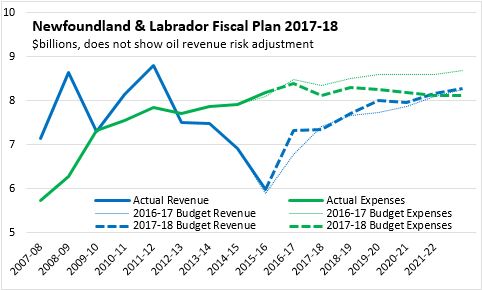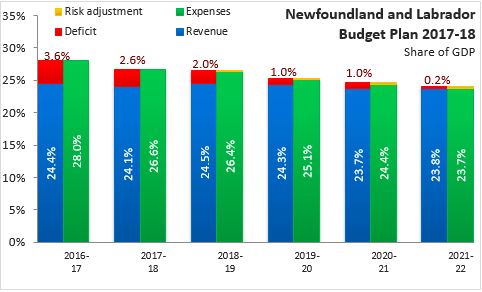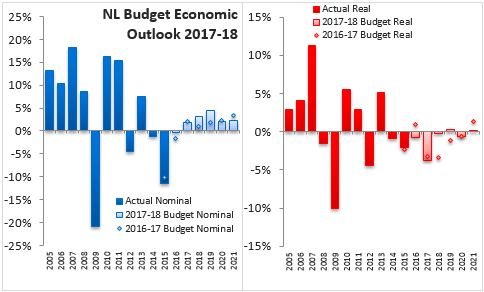The Economics and Statistics Division maintains archives of previous publications for accountability purposes, but makes no updates to keep these documents current with the latest data revisions from Statistics Canada. As a result, information in older documents may not be accurate. Please exercise caution when referring to older documents. For the latest information and historical data, please contact the individual listed to the right.
<--- Return to Archive
For additional information relating to this article, please contact:
April 07, 2017NEWFOUNDLAND AND LABRADOR BUDGET 2017-18 The Province of Newfoundland and Labrador introduced its 2017-18 Budget on April 6, featuring a deficit of $1.08 billion for 2016-17 (down from a Budget estimated to have a $1.83 billion deficit).
For 2017-18, Newfoundland and Labrador expects a deficit of $778 million as expenditures decline 3.4 per cent while revenues grow by 0.3 per cent. Through the rest of the fiscal planning horizon to 2022-23, Newfoundland and Labrador anticipates shrinking deficits as revenues rise by 2.4 per cent while expenditures rise in 2018-19, then fall back to the same levels as in 2017-18. By 2022-23, Newfoundland and Labrador anticipates a small surplus of $24 million. In the near term, Newfoundland and Labrador makes no provision for risk adjustment associated with oil prices. Starting in 2018-19 Newfoundland and Labrador's fiscal plan features an oil price risk adjustment rising from $50 million to $140 million in 2022-23.

Newfoundland and Labrador's lower deficit for 2016-17 came a result of revenues that were $544 million higher than planned, obviating the need for a $125 million revenue risk adjustment. Expenditures also came in $81 million lower than planned for 2016-17. Starting in 2017-18 and beyond, revenues are projected to be similar to those anticipated in last year's fiscal plan while expenditures are now projected to be lower - declining from 2018-19 through 2022-23.

As oil prices influence the size of nominal GDP in Newfoundland and Labrador, the provincial government's footprint in the economy has expanded to 28.0 per cent of nominal GDP in 2016-17 (expenditures). Through 2022-23, a return to nominal GDP growth with higher oil prices is expected to combine with limited spending to reduce government expenditures as a share of GDP to 23.7 per cent. Over the same time, rising revenues based particularly on rising prices will reduce government revenues as a share of GDP from 24.4 per cent to 23.8 per cent. Deficits are projected to decline from 3.6 per cent of GDP in 2016-17 to 0.2 per cent of GDP in 2022-23.

Newfoundland and Labrador's economic growth has been heavily influenced by the scale and price of oil production in the province. In 2015 alone, nominal GDP declined by 11.5 per cent as oil prices declined. At the same time, major oil project investments concluded, resulting in falling real GDP over 2014-2015 with an estimated further decline in real GDP for 2016. The Newfoundland and Labrador Budget assumes that real GDP decline by 3.8 per cent with falling output across most sectors as well as lower investment, exports, employment, household income, retail sales and population. In the medium term, there is expected to be further decline in real GDP. Nominal GDP growth is projected to be positive throughout 2017-2021, indicating that rising prices (especially for oil) will expand the Newfoundland and Labrador economy over the medium term.

Key Measures and Initiatives
The Newfoundland and Labrador Budget for 2017-18 includes a number of measures already announced in efforts to close the deficit. These include reduction of 400 management positions and adoption of zero-based budgeting practices. In addition to these measures, the government will wind down its temporary increase in the gasoline tax: by 8.5 cents/litre on June 1 and by a further 4 cents/litre on December 1. The government has also directed electric utility NALCOR to build reserves to lower electricity rates starting in 2020-21.
Newfoundland and Labrador Budget 2017-18
<--- Return to Archive